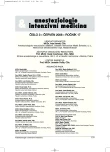Analysis of the specificity and sensitivity of procalcitonin in relation to other markers of inflammation in critically ill patients
Analýza specificity a senzitivity prokalcitoninu ve srovnání s dalšími markery zánětu u kriticky nemocných
Cíl práce:
Vyhodnocení specificity a senzitivity prokalcitoninu (PCT) ve srovnání s C-reaktivním proteinem (CRP) a dalšími markery zánětu ve vztahu ke klinickému stavu a mikrobiologickým nálezům nemocných lůžkové části kliniky AR.
Typ studie:
Prospektivní studie.
Název a sídlo pracoviště:
Klinika AR, 1. LF a VFN, Praha.
Soubor a metody:
U 43 nemocných bylo hodnoceno 164 vyšetření plasmatického PCT, CRP, orosomukoidu, prealbuminu, fibrinogenu, INR, leukocytů a trombocytů. Byla počítána skóre APACHE II první den a denně SOFA. Byla hodnocena přítomnost SIRS, MODS, pozitivita bakteriologického vyšetření, hemokultury a zjevného infektu. Pro statistiku byl využit chí-kvadrát, Wilcoxonův nepárový test, neparametrický Kruskalův-Wallisův test, ROC-analýza s výpočtem plochy pod křivkou (AUC) a porovnávány shody AUC pro dva různé analyty.
Výsledky:
Pro PCT, CRP, orosomukoid, albumin, prealbumin, leukocyty, fibrinogen, trombocyty, INR a tělesnou teplotu byly ROC-analýzou počítány AUC ve vztahu k následujícím parametrům (uvádíme pouze hodnoty AUC nad 0,6). MODS: teplota 0,700, PCT 0,683, trombocyty 0,657. Přítomnost SIRS: teplota 0,852, leukocyty 0,761, PCT 0,694, fibrinogen 0,612. SOFA: PCT 0,756, trombocyty 0,711, teplota 0,654, leukocyty 0,646. Hemokultura: albumin 0,703, fibrinogen 0,686, orosomukoid 0,666, teplota 0,649. APACHE: trombocyty 0,685, PCT 0,605, leukocyty 0,602. Bakteriologický nález: teplota 0,653, PCT 0,627. Zjevný infekt: teplota 0,694, fibrinogen 0,680. Významný vztah mezi přežívajícími a později na KAR zemřelými byl zjištěn u PCT (p = 0,00), trombocytů (p = 0,00), leukocytů (p < 0,03) a teploty (p < 0,05).
Závěr:
ROC-analýzou se PCT ukázal jako účinnější marker sepse a s ní souvisejících komplikací než CRP a další markery zánětu.
Klíčová slova:
prokalcitonin – C-reaktivní protein – reaktanty akutní fáze – ROC-analýza – SOFA – SIRS – MODS
Authors:
J. Valenta 1; A. Jabor 2,3; H. Brodská 4; Z. Stach 1; A. Kazda 2,4; M. Stříteský 1
Authors‘ workplace:
Klinika anesteziologie a resuscitace VFN a 1. LF UK Praha
1; Katedra klinické biochemie IPVZ Praha
2; Oddělení klinické biochemie Nemocnice Kladno
3; Ústav klinické biochemie a laboratorní diagnostiky VFN a 1. LF UK Praha
4
Published in:
Anest. intenziv. Med., 17, 2006, č. 3, s. 164-170
Category:
Intensive Care Medicine - Original Paper
Overview
Objective:
To evaluate the diagnostic specificity and sensitivity of procalcitonin (PCT) in comparison with C-reactive protein (CRP) and other inflammatory markers in relation to clinical status and microbiology examinations.
Design:
Prospective study in ICU patients.
Setting:
Department of Anaesthesiology and Intensive Care, University Hospital, 1st Medical Faculty, Charles University, Prague.
Materials and Methods:
164 examinations of PCT, CRP, orosomucoid, prealbumin, fibrinogen, INR, white cell and platelet count were evaluated in 43 patients. APACHE II was calculated on admission, SOFA daily. SIRS, MODS, microbiology findings, blood culture and signs of infection were also assessed. Statistical methods included chi-square, Wilcoxon unpaired test, nonparametric Kruskal-Wallis test, ROC analysis and comparison of area under the curve (AUC).
Results:
AUC higher than 0.6 was recorded in the following variables: MODS: temperature 0.700, PCT 0.683, platelets 0.657. SIRS: temperature 0.852, white cell count (WCC) 0.761, PCT 0.694, fibrinogen 0.612. SOFA: PCT 0.756, platelets 0.711, temperature 0.654, WCC 0.646. Blood culture: albumin 0.703, fibrinogen 0.686, orosomucoid 0.666, temperature 0.649. APACHE: platelets 0.685, PCT 0.605, WCC 0.602. Bacteriology: temperature 0.653, PCT 0.627. Apparent infection: temperature 0.694, fibrinogen 0.680. There was significant difference between survivors and non-survivors in PCT (P = 0.00), platelets (P = 0.00), WCC (P < 0.03) and temperature (P < 0.05).
Conclusion:
PCT was a more effective marker of sepsis-related complications in ICU patients than CRP or other markers of inflammation. ROC analysis was a suitable tool for confirmation of these relations.
Key words:
procalcitonin – C-reactive protein – acute phase reactants – ROC analysis – SOFA – SIRS – MODS
Labels
Anaesthesiology, Resuscitation and Inten Intensive Care MedicineArticle was published in
Anaesthesiology and Intensive Care Medicine

2006 Issue 3
Most read in this issue
- Surfactant – use in adult patients
- A comparison of haemodynamic changes using thoracic epidural anesthesia versus standard balanced anaesthesia during on-pump coronary artery bypass grafting
- Assessment of regional tissue perfusion by indicator microdialysis technique
- Assessment of performance of NMT stimulators used during anaesthesia in the Czech Republic
